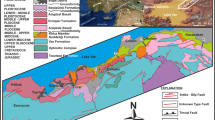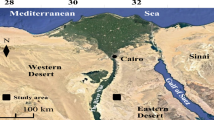Abstract
The present study focuses on the presence of gypsiferous foraminiferal packstone (GFP) facies which defines the top of the Lutetian aged Harudi Formation and separates it from the overlying Bartonian aged Fulra Limestone Formation. This facies has been reported from Harudi and Lakhpat areas of Kachchh District and may serve as a regressive stratigraphic boundary between the Harudi and Fulra Limestone Formations that had been previously considered as conformable succession. Here, the gypsum, halite and iron oxide minerals (hematite and/or goethite) are precipitated as secondary minerals in the desiccation cracks developed in the foraminiferal packstone facies. The precipitation of gypsum, halite and hematite/goethite along with desiccation cracks is suggestive of the oxidizing condition and would have been possible in supratidal environment under warm and dry semi-arid to arid climatic conditions. Thus, it is inferred that the cracks would have been formed during subaerial exposure of the foraminiferal packstone facies during relative sea-level fall.






Similar content being viewed by others
References
Bajpai S, Tripathi SC, Prasad V (2018) The Indian Paleogene. Soc Earth Sci. https://doi.org/10.1007/978-3-319-77443-5
Banerjee S, Chattoraj SL, Saraswati PK, Dasgupta S, Sarkar U (2012a) Substrate control on formation and maturation of glauconites in the Middle Eocene Harudi Formation, western Kutch, India. Mar Pet Geol 30:144–160
Banerjee S, Chattoraj SL, Saraswati PK, Dasgupta S, Sarkar U, Bumby A (2012b) The origin and maturation of lagoonal glauconites: a case study from the Oligocene Maniyara fort formation, western Kutch India. Geol J 47:357–371
Banerjee S, Khanolkar S, Saraswati PK (2018) Facies and depositional settings of the Middle Eocene–Oligocene carbonates in Kutch. Geodin Acta 30(1):119–136
Biswas SK (1982) Rift basins in western margin of India with special reference to hydrocarbon prospects. Bull Am Assoc Pet Geol 66:1497–1513
Biswas SK (1987) Regional tectonic framework, structure and evolution of the western marginal basins of India. Tectonophysics 135:307–327
Biswas SK (1992) Tertiary stratigraphy of Kutch. J Paleontol Soc India 37:1–29
Biswas SK (2005) A review of structure and tectonics of Kachchh basin, western India, with special reference to earthquakes. Curr Sci 88:1592–1600
Bohaty SM, Zachos JC, Florindo F, Delaney ML (2009) Coupled greenhouse warming and deep-sea acidification in the middle Eocene. Paleogeography 24(2):PA2207
Borchert H, Muir RO (1964) Salt deposits: the origin, metamorphism and deformation of evaporites. Van Nostrand-Reinhold, Princeton, 8.2.2, Fig. 8.2, 8.3., pp 338
Bosboom RE, Abels HA, Hoorn C, van den Berg BCJ, Gou Z, Dupont-Niet G (2014) Aridification in continental Asia after the Middle Eocene Climatic Optimum (MECO). Earth Planet Sci Lett 389:34–42
Chatterjee S, Goswami A, Scotese CR (2013) The longest voyage: tectonic, magnetic, and paleoclimatic evolution of the Indian plate during its northward flight from Gondwana to Asia. Gondwana Res 23:238–267
Chattopadhyay D, Sarkar D, Bardhan S, Mallick S, Das S (2011) A record of drilling predation and other biotic traces from larger benthic foraminifera of Eocene strata of Kachchh, Western India. Jahrestagung der Paläontologischen Gesellschaft, Abst 32, 48p
Clementz M, Bajpai S, Ravikant V, Thewissen JGM, Saravanan N, Singh IB, Prasad V (2011) Early Eocene warming events and timing of terrestrial faunal exchange between India and Asia. Geol Soc Am 39(1):15–18
Galazzo FB, Thomas E, Pagani M, Warren C, Luciani V, Giusberti L (2014) The middle Eocene climatic optimum (MECO): a multiproxy record of paleoceanographic changes in the southeast Atlantic (ODP Site 1263 Walvis Ridge). Paleoceanography. https://doi.org/10.1002/2014PA002670
Handford CR (1991) Marginal marine halite: sabkhas and salinas. In: Melvin JL (ed) Evaporites, petroleum and mineral resources. Elsevier, Amsterdam, pp 1–66
Hay WW, Migdisov A, Balukhovsky AN, Wold CN, Flogel S, Soding E (2006) Evaporites and the salinity of the ocean during the phanerozoic: implications for climate, ocean circulation and life. Palaeogeogr Palaeoclimatol Palaeoecol 240:3–46
Intxauspe-Zubiaurre B, Martinez-Braceras N, Payros A, Ortiz S, Dinares-Turell J, Flores J (2018) The last Eocene hyp[erthermal (Chron C19r event, ~ 41.5 Ma): chronological and paleoenvironmental insights from a continental margin (Cape Oyambre, N Spain). Paleogeogr Paleoclimatol Paleoecol 505:198–216
Jafar SA, Rai J (1994) Late middle Eocene (Bartonian) calcareous nannofossils and its bearing on coeval post-trappean transgressive event in Kutch Basin, western India. Geophytology 24:23–42
Jauhri AK (1991) Smaller benthic foraminifera from the middle Eocene of Kachchh, Western India. J Palaeontol Soc India 36:67–87
Kachhara RP, Jodhawat RL, Bigyapati Devi K (2011) Molluscan biostratigraphy of the palaeogene sediments around Lakhpat Kachchh, Gujarat, India. J Palaeontol Soc India 56(1):17–28
Kennett JP, Stott LDS (1991) Abrupt deep-sea warming, palaeoceanographic changes and benthic extinctions at the end of the Palaeocene. Nature 353:225–229
Khanolkar S, Saraswati PK (2019) Eocene foraminiferal biofacies in Kutch Basin (India) in context of paleoclimate and paleoecology. J Paleogeogr 8:21. https://doi.org/10.1186/s42501-019-0038-2
Koch PL, Zachos JC, Dettman DL (1995) Stable isotope stratigraphy and paleoclimatology of the Paleogene Bighorn Basin (Wyoming, USA). Paleogeogr Paleoclimatol Paleoecol 115:61–89
Liu X, Dong H, Rech JA, Matsumoto R, Yang B, Wang Y (2008) Evolution of ChakaSalt Lake in NW China in response to climatic change during the Latest Pleistocene–Holocene. Q Sci Rev 27:867–879
Özcan E, Saraswati PK, Hanif M, Ali N (2016) Orthophragminids with new axial thickening structures from the Bartonian of the Indian Subcontinent. Geol Acta 14(3):261–282
Pande K (2002) Age and duration of the Deccan Traps, India: a review of radiometric and paleomagnetic constraints. Proc Indian Acad Sci (Earth Planet Sci) 111:115–123
Rai J (1997) Scanning electron microscopic studies of the late middle Eocene calcareous nannofossils from the Kachchh basin, western India. J Palaeontol Soc India 42:147–167
Ravikant V, Bajpai S (2010) Strontium isotope evidence for the age of Eocene fossil whales of Kutch, western India. Geol Mag 147(03):473–477
Reading HG (1996) Sedimentary environments: processes facies and stratigraphy. Blackwell, Hoboken, p 688
Rego ES, Jovane L, Hein JR, Sant’Anna LG, Giorgioni M, Rodeli D, Özcan E (2018) Mineralogical evidence for warm and dry climatic conditions in the Neo-Tethys (eastern Turkey) during middle Eocene. Paleogeogr Paleoclimatol Paleoecol 501:45–57
Röhl U, Westerhold T, Bralower TJ, Zachos JC (2007) On the duration of the Paleocene–Eocene thermal maximum (PETM). Geochem Geophys Geosyst 8:12. https://doi.org/10.1029/2007GC001784
Samanta BK (1981) Two stratigraphically important Nummulites from the Middle Eocene of India and Europe. Palaeontology 24:803–826
Samanta BK, Bandopadhyay KP, Lahiri A (1990) The occurrence of Nummulites Lamark (Foraminiferida) in the Middle Eocene Harudi Formation and Fulra Limestone of Kutch, Gujarat, Western India. Bull Geol Min Metal Soc India 55:1–66
Saraswati PK, Patra PK, Banerji RK (2000) Biometric study of some Eocene Nummulites and Assilina from Kutch and Jaisalmer, India. J Palaeontol Soc India 45:91–122
Saraswati PK, Khanolkar S, Banerjee S (2018) Paleogene stratigraphy of Kutch, India: an update about progress in foraminiferal biostratigraphy. Geodinamic Acta 30(1):100–118
Saxena RK (1975) Lithostratigraphy of the Matanomadh Formation, Kachchh, India. Palaeobotanist 24:261–262
Self-Trail JM, Robinson MM, Bralower TJ, Sessa JA, Hajek EA, Kump LR, Trampush SM, Willard DA, Edwards LE, Powars DS, Wandless GA (2017) Shallow marine response to global climate change during the Paleocene–Eocene Thermal Maximum Salisbury Embayment, USA. Paleoceanograpgy. https://doi.org/10.1002/2017PA003096
Sengupta S, Nielsen JK (2009) Bioerosion in Middle Eocene larger foraminifera Nummulites obtusus (Sowerby) from Lakhpat, northwest Kachchh, Gujarat, India. Indian J Geosci 63:81–86
Sexton PF, Norris RD, Wilson PA, Pälike H, Westerhold T, Röhl U (2011) Eocene global warming events driven by ventilation of oceanic dissolved organic carbon. Nature 471(7338):349–352. https://doi.org/10.1038/nature09826
Singh BP (2013) Evolution of the Paleogene succession of the western Himalayan foreland basin. Geosci Front 4:199–212
Singh P, Singh MP (1991) Nannofloral biostratigraphy of the late Middle Eocene strata of Kachchh region, Gujarat State, India. Geosci J 12:17–51
Singh BP, Srivastava VK (2018) Petrographic, mineralogic and geochemical characteristics of the Paleocene lateritic bauxite deposits of Kachchh Basin, western India. Geol J. https://doi.org/10.1002/gj.3313
Singh SK, Kishore S, Misra PK, Jauhri AK, Gupta A (2010) Middle Eocene calcareous algae from southwestern Kachchh, Gujarat. J Geol Soc India 75:749–759
Singh BP, Singh N, Singh SP (2013) Modern salt (halite) deposits of the Sambhar Lake, Rajasthan and their formative conditions. Curr Sci 104(11):1482–1484
Singh BP, Singh YR, Andotra DS, Patra A, Srivastava VK, Guruaribam V, Sijagurumayum U, Singh GP (2016) Tectonically driven late Paleocene (57.9–54.7 Ma) transgression and climatically forced latest middle Eocene (41. 3–38.0 Ma) regression on the Indian subcontinent. J Asian Earth Sci 115:124–132
Singh BP, Srivastava VK, Kanhaiya S (2018) Sedimentological and geochemical characteristics of the late middle Eocene dolostone succession, Kachchh, western India. Geol J. https://doi.org/10.1002/gj.3378
Sinha R, Raymahashay BC (2004) Evaporite mineralogy and geochemical evolution of the Sambhar Salt Lake, Rajasthan, India. Sediment Geol 166:59–71
Smoot JP, Lowenstein TK (1991) Depositional environments of non-marine evaporites. In: Melvin JL (ed) Evaporites, petroleum and mineral resources. Elsevier, Amsterdam, pp 189–347
Srivastava VK, Singh BP (2017a) Facies analysis and depositional environments of the early Eocene Naredi Formation (Nareda locality), Kutch Western India. Carbonates Evaporites 32(3):279–293
Srivastava VK, Singh BP (2017b) Shoreface to estuarine sedimentation in the late Paleocene Matanomadh Formation, Kachchh, Western India. J Asian Earth Sci 136:1–15
Srivastava VK, Singh BP (2018) Depositional environments and sources for the middle Eocene Fulra limestone formation, Kachchh Basin, western India: evidences from facies analysis, mineralogy and geochemistry. Geol J. https://doi.org/10.1002/gj.3154
Srivastava DK, Gupta A, Jauhri AK (2008) A new regular echinoid from the middle Eocene of Kachchh Western India. J Paleontol Soc India 53(1):107–110
Srivastava VK, Singh BP, Kanhaiya S (2017) Facies characteristics and depositional environments of the middle Eocene (Lutetian) Harudi Formation Kachchh, Western India. Carbonates Evaporites. https://doi.org/10.1007/s13146-017-0398-6
Srivastava VK, Singh BP, Patra A (2018) Provenance of the late Paleocene Matanomadh Sandstones Kachchh, Western India. Indian Paleogene. https://doi.org/10.1007/978-3-319-77443-5_6
Sun J, Zhang L, Deng C, Zhu R (2008) Evidence for enhanced aridity in the TarimBasin of China since 5.3 Ma. Q Sci Rev 27:1012–1023
Svensen H, Planke S, Malthe-Sorenssen A, Jamtveit B, Myklebust R, Eidem TR, Rey SS (2004) Release of methane from a volcanic basin as a mechanism for initial Eocene global warming. Nature 429:524–527. https://doi.org/10.1038/nature02566
Syed R, Sarkar S, Sengupta S (2015) New evidences of shell-gravel taxa from Harudi Formation (Middle Eocene), Western Kachchh. J Geol Soc India 85:586–590
Tandon KK, Srivastava DK (1980) Hercoglossa Kachchhensis—a new species from the Middle Eocene rocks of Kachchh, India. J Palaeontol Soc India 23–24:55–57
Tucker ME, Wright VP (1990) Carbonate sedimentology. Blackwell Scientific Publication, Oxford, p 468p
Vail PR (1992) The evolution of seismic stratigraphy and the global sea-level curve. In: Dott RH Jr. (ed) Eustasy: the historical ups and downs of a major geological concept vol 180. Geological Society of America, Boulder, pp 83–91
Warren JK (2006) Evaporites: sediments, resources and hydrocarbons. Springer, Berlin
White LT, Lister GS (2012) The collision of India with Asia. J Geodyn 56–57:7–17
Zachos J, Pagani M, Sloan L, Thomas E, Billups K (2001) Trends, rhythms, and aberrations in global climate 65 Ma to present. Science 292:686–693
Zachos JC, Wara MW, Bohaty S, Delaney ML, Petrizzo MR, Brill A, Bralower TJ, Premoli-Silva I (2003) A transient rise in tropical sea surface temperature during the Paleocene–Eocene Thermal Maximum. Science 302:1551–1554
Zachos JC, Dickens GR, Zeebe RE (2008) An early Cenozoic perspective on greenhouse warming and carbon-cycle dynamics. Nature 451:279–283
Acknowledgements
The authors are thankful to the Director, Wadia Institute of Himalayan Geology (WIHG) for providing working facilities. AA is thankful to the Head of the Department of Geology, PG College of Gopeshwar for allowing her to carry out her winter internship at WIHG. Director, IIT-BHU is thanked for allowing VKS to carry out the mineralogical, morphological and elemental studies on Rigaku X-ray diffractometer and ZIESS EVO 18 SEM–EDS machine respectively, housed at the Central Instrumentation Facility Centre of the campus. VKS is also grateful to the SERB—DST, New Delhi, for the financial assistance in the form of the NPDF Project (File no. PDF/2017/001527). The authors are grateful to the journal reviewers for suggesting modifications in the manuscript that improved the quality of the manuscript.
Author information
Authors and Affiliations
Corresponding author
Additional information
Publisher's Note
Springer Nature remains neutral with regard to jurisdictional claims in published maps and institutional affiliations.
Rights and permissions
About this article
Cite this article
Srivastava, V.K., Aggarwal, A. Middle Eocene regressive phase evident in the uppermost part of the Harudi Formation, Kachchh Basin, western India. Carbonates Evaporites 35, 17 (2020). https://doi.org/10.1007/s13146-020-00549-w
Accepted:
Published:
DOI: https://doi.org/10.1007/s13146-020-00549-w




